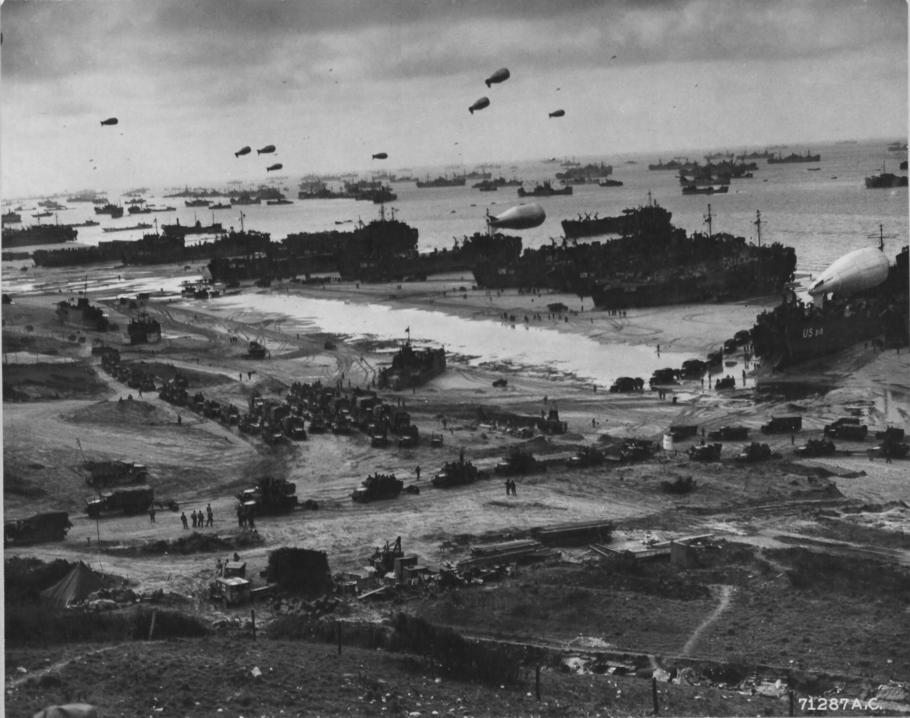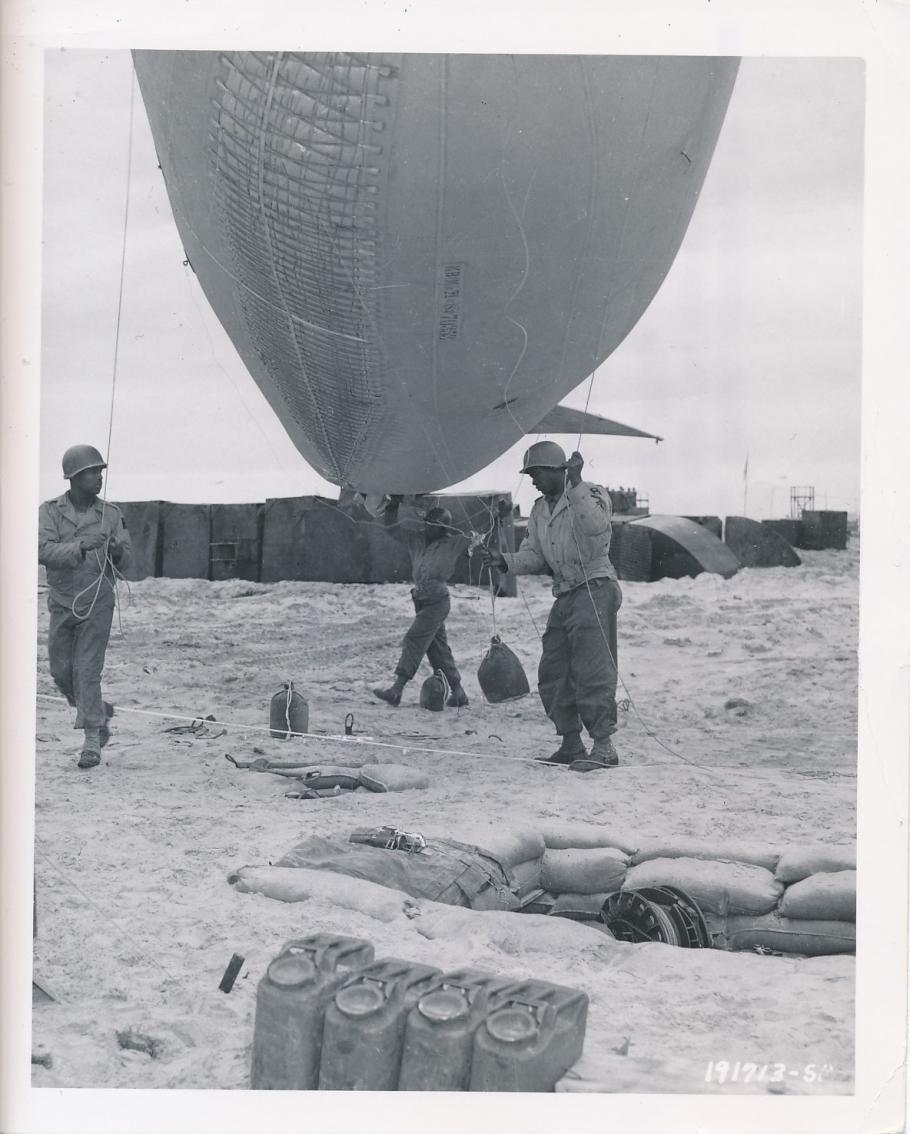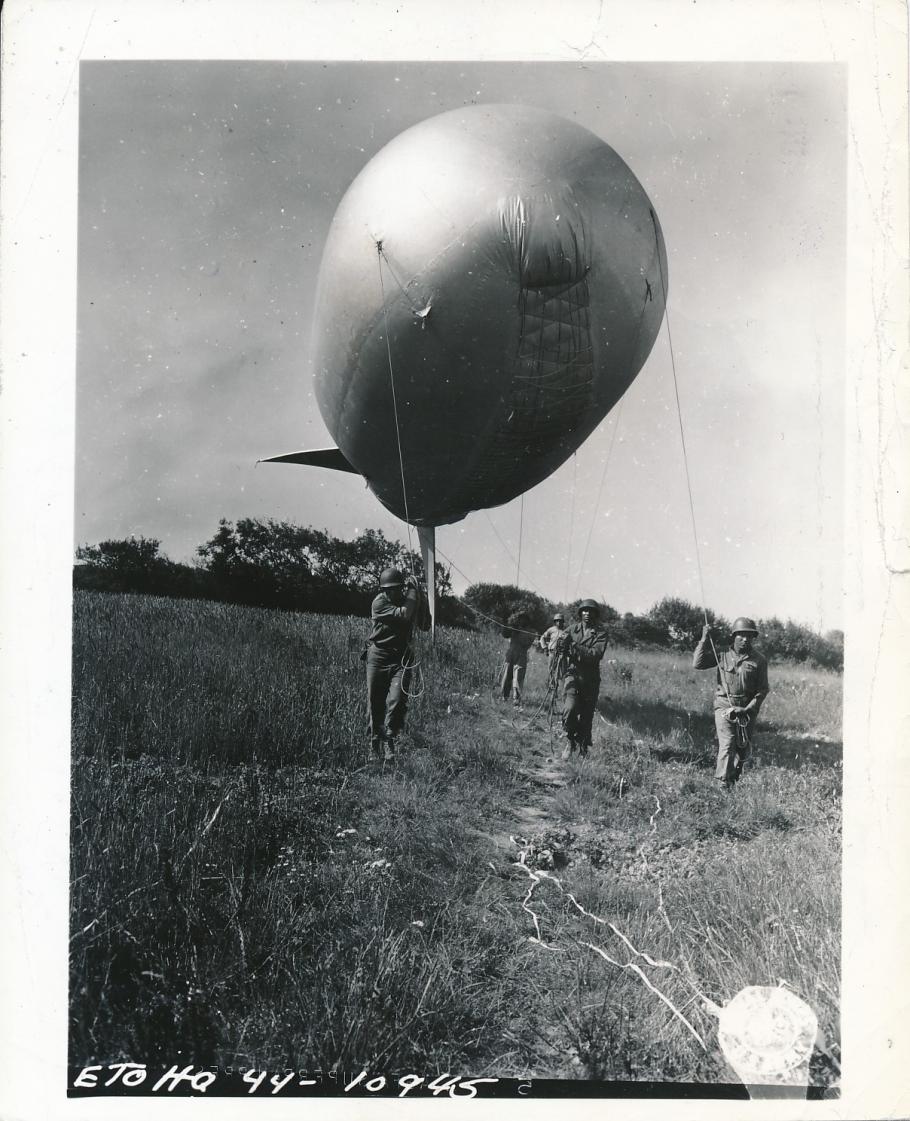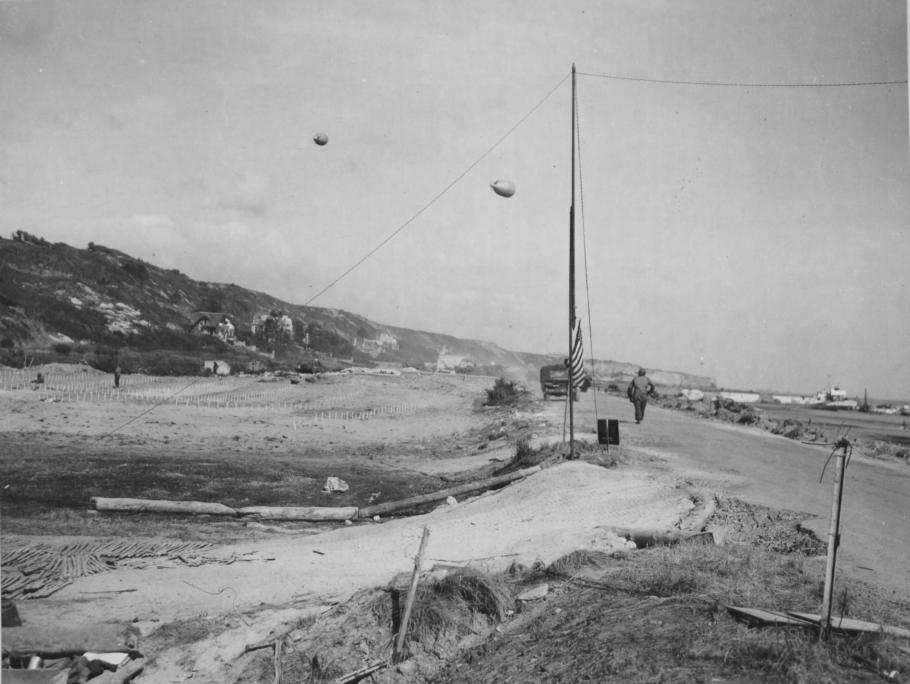One of the most iconic images of the D-Day invasion was taken shortly after the initial invasion itself. The image features several LSTs (Landing Ship, Tank) beached along the coast of France while dozens of military vehicles drive off them and thousands of pounds of supplies and equipment are unloaded in order to support the continuation of the invasion. Floating above most of the ships, stretching into the distance, are silver oval shaped balloons. These balloons, known as barrage balloons, may seem at first glance out of place in a major military invasion. They were, however, vital to the operation, and were brought ashore in the invasion’s first wave by the brave men of the 320th Barrage Balloon Battalion, the only unit comprised entirely of African American soldiers to storm the beach that day. They provided critical protection to the ships and soldiers below them from attacks by enemy aircraft, and continue to provide us a glimpse into the U.S. military’s use of balloon technology.
Barrage balloons protect dozens of ships on the Normandy beaches as they offload the men, material, and munitions needed to expand the beachhead. NARA 342-FH-3A17185-71287AC
Balloons as a Military Tool
The U.S. military was not always interested in the barrage balloon for military operations, and the program took several decades to develop. The development of barrage balloons began during World War I and was undertaken by many of the European nations in the war. Britain invested in them as a means of defending London and other cities from German bombing raids, while France used them to protect strategically important areas, such as railroads and aqueducts, from aerial attacks. Barrage balloons worked as both a passive and active means of aerial defense.
Floating barrage balloons over a specific area prevented enemy aircraft from flying close enough to target the area from directly overhead with bombs or strafing fire. If an enemy aircraft was determined to attack, the balloons forced them to fly at higher altitudes (to fly over the balloons) making them more susceptible to larger caliber anti-aircraft gunfire. The balloons themselves could also destroy enemy aircraft, especially at night: the cables that anchored the balloons to the ground were very difficult to see and posed a risk to any aircraft that flew into them. An aircraft caught in a cable could be slowed down enough to stall or have a wing torn off.
After the First World War ended, the U.S. military decided that it was important to investigate means of defending areas from aerial attack. In 1923, the United States Army decided to study which anti-aircraft defenses would be most effective to develop. The Army Air Service argued that barrage balloons would be an inexpensive and effective means of protecting strategically important locations, such as the Panama Canal. The Air Service was given permission to develop barrage balloons for the military. This decision, however, set off an inter-agency feud with the Coast Artillery Corps, which thought that barrage balloons would fit in better with the other anti-aircraft defense items already under their command. It was eventually decided that the Air Service would be placed in charge of developing barrage balloon technology, but the Coast Artillery Corps would actually operate the balloons.
The development of U.S. barrage balloons was slow and suffered greatly from both a lack of funding and a widespread lack of enthusiasm for the program. Only minor developments occurred between 1923 and 1939, and the inter-service rivalry between the Air Corps and the Coastal Artillery Corps continued throughout the years. The coming of war in Europe in 1939 brought about renewed vigor for the development of barrage balloons, and on March 14, 1941, the General Staff of the U.S. military designated barrage balloons to be in joint control of both the Air Corps and the Coastal Artillery Service, and both units began to coordinate their efforts. One of the first decisions needed from the joint command was where to set up a permanent training base for barrage balloon battalions. The first and only base set up in the United States for this purpose was located near Paris, Tennessee, and was named Camp Tyson.
Barrage Balloon training in Camp Tyson, Tennessee. Library of Congress, LC-USE6-D-008677
Although the joint command was in the process of developing the barrage balloon units almost from nothing, the Japanese attack on the U.S. fleet in Pearl Harbor on December 7, 1941, brought the barrage balloon program to the forefront. Following the attack, Chief of the Coast Artillery General Joseph A. Green ordered that every possible effort be made to send three barrage balloons battalions to the west coast to protect important locations including the Bremerton Navy Yard in Bremerton, Washington and the Boeing aircraft plant in Seattle, Washington. A lack of equipment meant that this task could not be completed until the spring of 1942. The Air Corps and Coastal Artillery Corps would continue to develop new equipment, new balloons, and new techniques. By the end of 1942, however, what was needed most was new recruits; this is where the story of the 320th Barrage Balloon Battalion begins.
The 320th Barrage Balloon Battalion
Camp Tyson, Tennessee, became the home of the barrage balloon battalions at the end of 1942 as units that had begun training elsewhere in the U.S. were moved to the newly built camp. The camp would produce over thirty barrage balloon battalions, including four comprised entirely of African American recruits: the 318th, 319th, 320th, and 321st Barrage Balloon Battalions. Each battalion consisted of 1,100 men and over 50 balloons.
After passing basic training, the battalions began six weeks of balloon training, where they learned the skills needed to handle barrage balloons in combat. The balloons issued to these troops were known as very low altitude (VLA) balloons, which were about 35 feet in length and operated below 2,000 feet. They learned how to carefully fill the balloons with over 3,000 cubic feet of inflammable hydrogen gas, preventing sparks or static electricity which could catch them afire. They learned how to camouflage the balloons, repair them, and generally maintain them on the battlefield. They also learned how to attach and arm a small explosive charge to the cable that anchored the balloons to the ground. If an enemy aircraft struck the cable while flying near the balloons, the cable would snag on the wing and bring the explosive towards the wing, causing it to explode.
Once recruits passed balloon training, they ended their time at Camp Tyson with twelve weeks of weather forecasting training. Controlling the 35-foot balloons in sharp winds or bad weather could be incredibly difficult, if not dangerous, so recruits needed to know how to predict what to expect.
The Role of Balloons in the D-Day Invasion
After completing training, the 320th Barrage Balloon Battalion boarded ships to England in preparation of the invasion of continental Europe. The 320th were just one of the thousands of units who prepared for the invasion and trained for their specific role. The 320th was spread across over 100 landing craft that day destined for the Omaha and Utah beaches, the stretches of French coast assigned to the American military to secure. Barrage balloons were inflated in England and attached to the various ships taking part in the invasion for the trip across the English Channel.
The soldiers of the 320th, in teams of four to five men, were assigned the task of moving the pre-inflated balloons from the ships to the shore in order to protect the landing forces from expected German aerial attacks. Over 600 men of the 320th would be part of the assault force to accomplish this task, and a majority would land on Omaha beach. As with most of the plans for that day, things went awry for the battalion once they landed.
The bombardment of Omaha beach by naval and air forces before the amphibious landings did not knock out as many German defensive positions as expected, and the first waves of troops, including the 320th, faced withering machine gun and artillery fire. Many of the balloons were shot up and destroyed before they could even be brought off the ships, and the soldiers of the 320th did what they could to survive. On Utah beach, the men of the 320th did not face as much of a maelstrom as on Omaha, but lost their balloons nonetheless. They were able to bring over 20 balloons onto the beach, but many were ordered to be cut loose because some commanders on the beach thought they were drawing enemy artillery fire. As the Allied forces began to take hold of beachheads, Colonel Leon J. Reed, the commander of the 320th, struggled to find his soldiers scattered amongst the chaos, as well as any equipment that survived the initial attacks.
It was important to have the barrage balloons airborne before night, when it was expected that most enemy aerial attacks would come. Despite the overwhelming odds against them, the 320th had one balloon aloft over the eastern end of Omaha beach by 11:15 pm on the night of June 6, and would have 12 balloons aloft by dawn the next morning. These balloons were quickly destroyed by enemy fire, but more balloons were brought ashore, and by the night of June 7, 20 balloons were aloft over Omaha beach, and 13 balloons were aloft over Utah beach.
Corporal A. Johnson moves a balloon with some of his team over the invasion beaches, 24 July 1944. NARA 111-SC-191713
Balloons would continue to be shot down and replaced over the early days of the invasion, and the expected German aerial attacks would continue through June and July. Throughout those opening weeks of the invasion, the 320th continued its mission to ensure that balloons were raised over the landing beaches, especially at night, to continue to protect ships bringing the critical soldiers, materials, and supplies needed for Allied success. During the day, the balloons were lowered as Allied aircraft patrolled the skies, and the men of the 320th assisted in off-loading supplies from the never-ending stream of ships arriving at the beachhead each day. During this time, the 320th was credited with taking down at least one German aircraft when it was caught in one of the cables of a balloon and crashed into the English Channel. The National Museum of African American History and Culture has some souvenirs picked up from a member of the 320th Barrage Balloon Battalion during their time in Normandy, including some stones picked up on June 6, 1944.
From left to right, PFC Arko Shaw, PFC Alvin Smith, Cpl. Jessie Sumlin, and Pvt. James Shrapshire hauling a barrage balloon through a partly cleared mine field to a new site in France, 22 August 1944. NARA 111-SC-192592
The 320th Barrage Balloon Battalion served for almost 150 days in France following the invasion. They continued flying their balloons over the beaches and eventually a portion flew over the port of Cherbourg before the worsening weather in October prevented ships from landing any more supplies. They returned to England, and eventually back to the United States, where it prepared to support the war in the Pacific theater. The battalion was eventually moved to Hawaii, but the war ended before they entered combat again.
For their work on Omaha beach, the battalion received a commendation from Supreme Commander of the Allied Expeditionary Forces in Europe General Dwight D. Eisenhower. Although their service was unique to the D-Day invasion, they played a critical role in the success of the invasion which would eventually bring an end to German control of Europe. As Allied infantry forces moved further inland from the original invasion beaches, the 320th Barrage Balloon Battalion helped keep the vital artery of supplies open to keep the soldiers fed, armed, and bandaged, and protected both the living and the dead who remained on the Normandy beaches.
Barrage balloons fly overhead as the American flag flies at half-mast nearby one of the first American cemeteries created for those lost on Omaha beach. NARA 342-FH-3A16622-3A16622
For more information on the 320th Barrage Balloon Battalion, please read Forgotten by Linda Hervieux.





